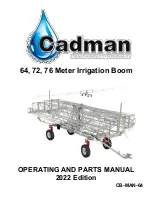
39
section. Refer to
5-7 Interlock and Interlock Clear – IL(02) and ILC(03)
for
details on interlocks.
3-10
Program Memory
Program Memory is where the user program is stored. The amount of Pro-
gram Memory available is either 8K,16K, 24K or 32K words, depending on
the type of Memory Unit mounted to the CPU. These memory capacities cor-
respond to approximately 7.7K, 15.4K, 23.1K and 30.8K instructions, but the
actual number of instructions will vary depending on the instructions actually
used.
Memory Units come in different types, such as RAM and ROM Units, and for
each type there are different sizes. (Refer to the
Installation Guide
for de-
tails.)
To store instructions in Program Memory, input the instructions through the
Programming Console, or download programming data from a FIT, floppy
disk, cassette tape, or host computer, or from a File Memory Unit if one is
mounted to the CPU Rack. Refer to the end of
Appendix A Standard Prod-
ucts
for information on FIT and other special products. Programming Console
operations, including those for program input, are described in
Section 7 Pro-
gram Input, Debugging, and Execution
.
3-11
File Memory
The File Memory (FM) is available only when a File Memory Unit is mounted
to the PC. This area, contained in RAM within the File Memory Unit, can be
used for data storage and retrieval. Program Memory and/or IR, SR, DM, LR,
HR, AR, and TC area data can be stored in or retrieved from FM.
The area is accessible in block units only. The block numbers are 4-digit
BCD, and each block consists of 128 words.
File Memory addresses are by block and range from 0000 through 0999 or
from 0000 through 1999, depending on the model of File Memory Unit that is
used. Refer to
Appendix A Standard Models
for File Memory Unit models
and to
5-24 File Memory Instructions
for instructions to transfer data to and
from File Memory.
The File Memory retains data during power interruptions or when PC opera-
tion is stopped.
3-12
Trace Memory
The Trace Memory is used to store the results of execution traces. Trace op-
erations are explained in
5-23 Trace Operations
.
3-13
TR (Temporary Relay) Area
The TR area provides eight bits that are used only with the LD and OUT in-
structions to enable certain types of branching ladder diagram programming.
The use of TR bits is described in
Section 4 Writing and Inputting the Pro-
gram
.
TR addresses range from TR 0 though TR 7. Each of these bits can be used
as many times as required and in any order required as long as the same LR
bit is not used twice in the same instruction block.
TR Area
Section 3-13
















































